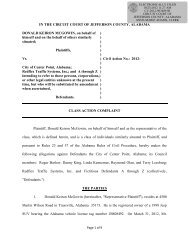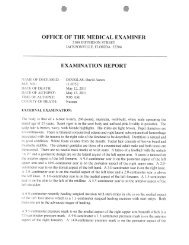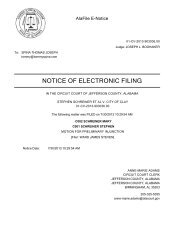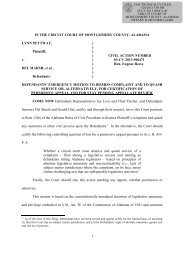Sentenced to Stigma: Segregation of HIV-Positive Prisoners - AL.com
Sentenced to Stigma: Segregation of HIV-Positive Prisoners - AL.com
Sentenced to Stigma: Segregation of HIV-Positive Prisoners - AL.com
Create successful ePaper yourself
Turn your PDF publications into a flip-book with our unique Google optimized e-Paper software.
To be sure, the presence <strong>of</strong> high risk behavior in prisons such as sexual activity, injectiondrug use and tat<strong>to</strong>oing is well documented. 131 However, data on in-prison rates <strong>of</strong>transmission <strong>of</strong> <strong>HIV</strong> are scarce. Studies thus far have documented rates <strong>of</strong> transmission thatare “low, but not negligible.” 132 One study found that between 1988 and 2005, 88 prisonersseroconverted <strong>to</strong> <strong>HIV</strong> in the Georgia State Department <strong>of</strong> Corrections, with transmissionrelated <strong>to</strong> sexual activity and tat<strong>to</strong>os. 133 A 2006 study in a southeastern state identified a .63percent seroconversion rate (33 <strong>of</strong> 5,265 male prisoners) over a period <strong>of</strong> 22 years. 134Today, there is a developing body <strong>of</strong> evidence demonstrating that harm reduction programsincluding condom availability, syringe exchange and medication-assisted therapy forprisoners dependent on heroin and other opioids reduce the risk <strong>of</strong> transmission <strong>of</strong> <strong>HIV</strong> andother sexually transmitted infections (STIs) as well as Hepatitis B and C in prisons. 135 None <strong>of</strong>these approaches are available in any <strong>of</strong> the three states, though Mississippi does makecondoms available for prisoners on conjugal visits. <strong>HIV</strong>-positive prisoners, however, are noteligible for conjugal visits. 136In 2007, the World Health Organization (WHO), the United Nations Agency on AIDS (UNAIDS),and the United Nations Office on Drugs and Crime (UNODC) conducted a world-wideliterature review evaluating the efficacy and feasibility <strong>of</strong> prison condom distributionprograms. The report found that prisoners use condoms <strong>to</strong> reduce transmission <strong>of</strong> <strong>HIV</strong> andother STIs, with no negative consequences <strong>to</strong> security, and with a high level <strong>of</strong> acceptance131 See, e.g., C.P. Krebs et al, “Intraprison transmission: an assessment <strong>of</strong> whether it occurs, how it occurs, and who Is atrisk,” AIDS Education and Prevention 14(Supp. B) (2002): 53; A. Spaulding et al, “Can unsafe sex behind bars be barred?”American Journal <strong>of</strong> Public Health 91(8) (2001) 1176; N. Mahon, “New York inmates’ <strong>HIV</strong> risk behaviors: the implications forprevention policy and programs,” American Journal <strong>of</strong> Public Health 86 (1996):1211; and Human Rights Watch, No Escape:Male Rape in US Prisons, 2001. For a global review <strong>of</strong> studies examining sexual activity in prisons, see WHO, Evidence forAction Technical Papers: Interventions <strong>to</strong> Address <strong>HIV</strong> in Prison, Prevention <strong>of</strong> Sexual Transmission, (Geneva 2007). Jurgensand G. Betteridge, “<strong>Prisoners</strong> who inject drugs,” Health and Human Rights, vol. 8 (2005); T. Abiona et al, “Body art practicesamong inmates: implications for transmission <strong>of</strong> bloodborne infections,” American Journal <strong>of</strong> Infection Control (Oct 2009)...132 Okie, S. “Sex, Drugs, Prisons, and <strong>HIV</strong>” New England Journal <strong>of</strong> Medicine 356 (2007) 105-108,p. 106.133 Centers for Disease Control and Prevention, “<strong>HIV</strong> Transmission Among Male Inmates in a State Prison System --- Georgia,1992—2005,” MMWR,vol. 55, no. MM15, April 21, 2006, p. 421. This study estimates that the 88 prisoners seroconverting inprison represented 9 percent <strong>of</strong> all <strong>HIV</strong>-positive prisoners in the Georgia State prisons, though the actual percentage may behigher or lower due <strong>to</strong> variables not in the scope <strong>of</strong> the investigation.See, Jafa,K. et al. “<strong>HIV</strong> Transmission in a State PrisonSystem 1988–2005”, PLoS ONE 4(5): (2009) e5416,doi10.1371/journal.pone.0005416.134 Krebs, C.P. “Inmate Fac<strong>to</strong>rs Associated with <strong>HIV</strong> Transmission in Prison” Criminology and Public Policy, 51 (2006) 113-136.135 See, e.g. “Harm Reduction in Prison: the Moldova Model,” Open Society Institute Public Health Program, July 2009;WHO/UNODC/UNAIDS, Evidence for Action Technical Papers-Interventions <strong>to</strong> Address <strong>HIV</strong> in Prisons. Comprehensive Review.Geneva, 2007; Correctional Services <strong>of</strong> Canada, “Evaluation <strong>of</strong> <strong>HIV</strong>/AIDS Harm Reduction Measures in the Correctional Service<strong>of</strong> Canada,” April 1999.136 Mississippi Department <strong>of</strong> Corrections, “Conjugal Visits”, online, http://www.mdoc.state.ms.us/conjugal_visits.htm(Accessed March 17, 2010).<strong>Sentenced</strong> <strong>to</strong> <strong>Stigma</strong> 42















